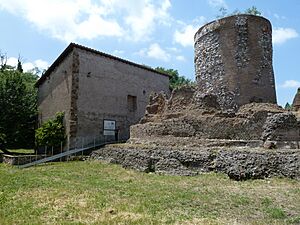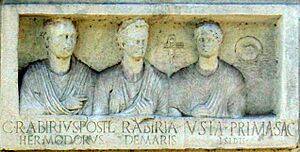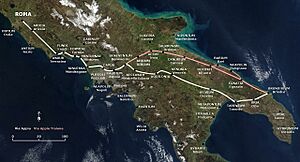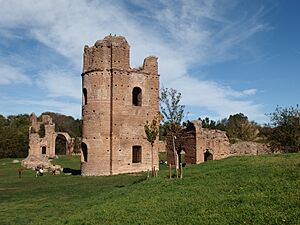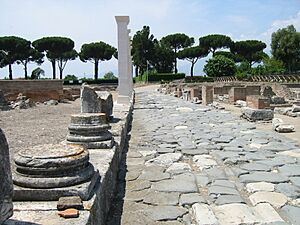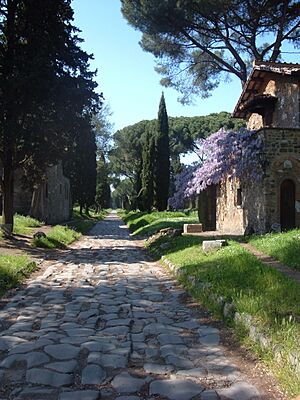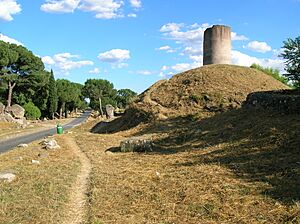Appian Way facts for kids
|
Via Appia
|
|
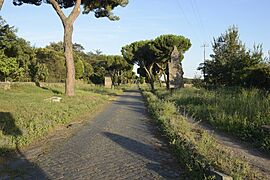 |
|
| Location | Roman Forum, Rome to Brindisi |
|---|---|
| Coordinates | 41°50′29″N 12°31′57″E / 41.84139°N 12.53250°E |
| Type | Roman road |
| History | |
| Builder | Appius Claudius Caecus, addition by Trajan (Via Appia Traiana) |
| Founded | 312–264 BC |
The Appian Way (in Latin and Italian: Via Appia) was one of the earliest and most important Roman roads in ancient Rome. It connected the city of Rome to Brindisi in southeast Italy. People often called it the "Queen of the Long Roads," showing how important it was.
The road is named after Appius Claudius Caecus. He was a Roman censor (a high-ranking Roman official). He started building the first part of this military road in 312 BC during the Samnite Wars.
Contents
Why Was the Appian Way Built?
Rome's Need for Roads
The Appian Way was a vital Roman road. It was used to move military supplies and improve communication. This was especially important for Rome's conquest of southern Italy.
It was the first long road built specifically to transport troops. This was crucial for Rome's expansion beyond its local area. Before this, most roads outside Rome were Etruscan. They mainly led to Etruria. By the late Republic, Romans had spread across most of Italy. They were experts at building roads. All their roads started in Rome, leading to the saying, "All roads lead to Rome."
Overcoming the Marshes
Between Rome and the southern city of Capua lay the Pontine Marshes. This was a swamp filled with malaria. Traveling through it was very difficult. During the First Samnite War (343–341 BC), Romans found it hard to supply their troops across this marsh.
They needed a better way to move soldiers and supplies. So, they looked for a solution.
Appius Claudius's Vision
In 312 BC, Appius Claudius Caecus became a Roman censor. He was a smart and determined leader. Without waiting for the Senate's approval, he started big public projects.
He built an aqueduct (the Aqua Appia) to bring water to Rome. But his most famous project was the Appian Way. This road went straight across the Pontine Marshes to the coast. Then it turned north to Capua. This road allowed fresh troops and supplies to move quickly. They could reach battle areas without problems from enemies or difficult land.
The Road's Success
The Appian Way helped Rome greatly. It allowed them to move their armies fast. They could also keep their soldiers well-supplied. This made them a very strong opponent. The road played a key role in Rome winning the Second Samnite War.
How the Road Was Built
The main part of the Appian Way was started and finished in 312 BC.
The road began as a flat dirt path. Then, small stones and mortar were laid down. On top of this, gravel was added. Finally, tightly fitting, interlocking stones were placed to create a flat surface. The historian Procopius said the stones fit so well they looked like they had grown together.
The road was slightly curved in the middle. This helped water drain off. There were also ditches on both sides, protected by low walls. The Appian Way is thought to be the first Roman road to use lime cement. The building materials were volcanic rock. The surface was so smooth that you couldn't see the joints between the stones.
From Rome to Lake Albano
The road started in the Roman Forum. It passed through the Servian Wall at the Porta Capena. Then it left the city. Later, the Aurelian Wall was built, and another gate, the Porta Appia, was added. Outside Rome, the new Via Appia went through wealthy areas. The Roman section of the road still exists. It is lined with many ancient monuments.
Across the Marsh
The road went straight through the Alban hills, using cuts and fills. The slopes were steep. Then it entered the former Pontine Marshes. A stone causeway, about 30 kilometers (19 miles) long, crossed these swampy areas. Appius Claudius tried to drain the marsh, but he didn't succeed. The causeway and its bridges needed constant repairs. Later, a canal was built alongside the road. This helped with traffic and offered an alternative when the road was being fixed.
Extending the Road
The Appian Way originally ended at Capua. But Rome kept expanding. During the Third Samnite War (298–290 BC), the road was extended. It went 56 kilometers (35 miles) beyond Capua to a place called Beneventum.
By 290 BC, Rome had defeated the Samnites. The southern part of Italy was now open to them. The Romans extended the road even further to Venusia. Then, by 264 BC, the Appian Way reached the port of Brundisium. This made it easier for Rome to control all of Italy. Even though Appius Claudius died in 273 BC, his name stayed with the road.
Later Branches
Because some parts of the Appian Way were difficult to travel, new branches were built. Emperor Trajan built the Via Traiana. This was a branch of the Via Appia from Beneventum. It reached Brundisium through different cities like Canusium and Bari. An arch in Beneventum celebrates this new branch.
Famous Events on the Appian Way
Spartacus's Rebellion

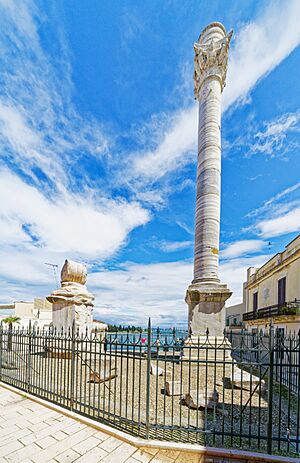
In 73 BC, a slave revolt began. It was led by Spartacus, a former gladiator from Capua. Slaves made up about one-third of the people in Italy.
Spartacus defeated many Roman armies over two years. But eventually, his army was defeated by Marcus Licinius Crassus. Thousands of rebels were captured or killed. The Romans punished the slaves severely. In 71 BC, 6,000 captured slaves were put to death along the 200-kilometer (124-mile) stretch of the Via Appia from Rome to Capua.
World War II Battle
In 1943, during World War II, the Allies faced challenges in the Pomptine fields. These marshes had been drained by Benito Mussolini's engineers.
The Allies landed on the coast of Italy at Anzio. They hoped to move along the Appian Way to take Rome. But they didn't move fast enough. German forces occupied the nearby mountains. They attacked the Allies. The battle lasted four months. In May 1944, the Allies broke out of Anzio and captured Rome.
1960 Summer Olympics
The Appian Way was also part of the men's marathon course. This was during the 1960 Summer Olympics in Rome. Abebe Bikila from Ethiopia won the race there.
Main Sights Along the Road
Via Appia Antica
After the fall of the Western Roman Empire, the old road was not used much. Later, in 1784, a new Appian Way was built next to it. This new road is called the Via Appia Nuova ("New Appian Way"). The old section is now known as Via Appia Antica ("Old Appian Way").
The old Appian Way near Rome is now a popular tourist attraction. It was restored for Rome's Millennium and Great Jubilee celebrations. The first 3 kilometers (2 miles) are still used by cars and buses. But after that, there is very little traffic. You can explore the ruins safely on foot.
The Church of Domine Quo Vadis is on the second mile of the road. Near Rome, there are also three catacombs (underground burial places) of Roman and early Christian origin. There is also one of Jewish origin.
Rome's ring road, the Grande Raccordo Anulare (GRA), cut the Appian Way in two in 1951. But now, a tunnel under the GRA allows you to walk about 16 kilometers (10 miles) of the Appian Way from its start.
Many parts of the original road outside Rome are still preserved. Some are even used by cars today. The road inspired the last part of Ottorino Respighi's famous music piece, Pini di Roma. Today, the Via Appia still has the longest straight stretch of road in Europe, measuring 62 kilometers (38.5 miles).
Monuments Along the Via Appia
1st to 4th mile
- Porta Appia (Porta San Sebastiano), a gate in the Aurelian Walls
- Church of Domine Quo Vadis
- Tomb of Priscilla
- Catacomb of Callixtus
- Hypogeum of Vibia
- San Sebastiano fuori le mura
- Catacombs of St Sebastian
- Vigna Randanini Jewish catacombs
- Circus of Maxentius
- Tomb of Caecilia Metella
- Roman baths of Capo di Bove
- Tomb of Hilarus Fuscus
5th mile
- Mausoleum of the Orazi and Curiazi
- Villa dei Quintili, with a nympheum (water fountain), theater, and baths
- Mausoleum of Casal Rotondo
6th mile and beyond
- Minucia tomb
- Torre Selce
- Temple of Hercules
- Berrettia di Prete (a tomb that later became a church)
- Mausoleum of Gallienus
- Tres Tabernae
- Villa of Publius Clodius Pulcher (at Villa Santa Caterina), 14th mile
- Villa of Pompey
Roman Bridges
There are remains of several Roman bridges along the road. These include the Ponte di Tre Ponti, Ponte di Vigna Capoccio, Viadotta di Valle Ariccia, Ponte Alto, and Ponte Antico.
See Also
 In Spanish: Vía Apia para niños
In Spanish: Vía Apia para niños
- Appian Way Regional Park
- Park of the Caffarella – a park next to the northern side of the Appian Way
- Roman bridge
- Roman engineering
- Three Taverns
- The Pines of the Appian Way – a part of Ottorino Respighi's music piece Pines of Rome




